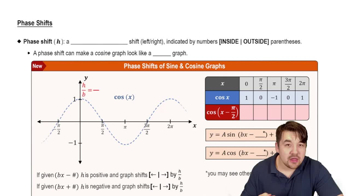Table of contents
- 0. Review of College Algebra4h 43m
- 1. Measuring Angles39m
- 2. Trigonometric Functions on Right Triangles2h 5m
- 3. Unit Circle1h 19m
- 4. Graphing Trigonometric Functions1h 19m
- 5. Inverse Trigonometric Functions and Basic Trigonometric Equations1h 41m
- 6. Trigonometric Identities and More Equations2h 34m
- 7. Non-Right Triangles1h 38m
- 8. Vectors2h 25m
- 9. Polar Equations2h 5m
- 10. Parametric Equations1h 6m
- 11. Graphing Complex Numbers1h 7m
4. Graphing Trigonometric Functions
Graphs of Tangent and Cotangent Functions
Problem 4.17a
Textbook Question
Graph each function over a one-period interval.
y = sec (x + π/4)
 Verified step by step guidance
Verified step by step guidance1
Identify the basic function: The function given is \( y = \sec(x + \frac{\pi}{4}) \). The secant function, \( \sec(x) \), is the reciprocal of the cosine function, \( \sec(x) = \frac{1}{\cos(x)} \).
Determine the period of the function: The period of the secant function is the same as the cosine function, which is \( 2\pi \). Therefore, the period of \( \sec(x + \frac{\pi}{4}) \) is also \( 2\pi \).
Identify the phase shift: The expression \( x + \frac{\pi}{4} \) indicates a phase shift. The graph of the function is shifted to the left by \( \frac{\pi}{4} \) units.
Determine the vertical asymptotes: The secant function has vertical asymptotes where the cosine function is zero. Solve \( \cos(x + \frac{\pi}{4}) = 0 \) to find the asymptotes within one period.
Sketch the graph: Plot the vertical asymptotes, and sketch the secant function, which will have branches opening upwards and downwards between the asymptotes. Ensure the graph reflects the phase shift and covers one full period of \( 2\pi \).
Recommended similar problem, with video answer:
 Verified Solution
Verified SolutionThis video solution was recommended by our tutors as helpful for the problem above
Video duration:
0m:0sPlay a video:
Was this helpful?
Key Concepts
Here are the essential concepts you must grasp in order to answer the question correctly.
Secant Function
The secant function, denoted as sec(x), is the reciprocal of the cosine function. It is defined as sec(x) = 1/cos(x). The secant function has a period of 2π, meaning it repeats its values every 2π units. Understanding the behavior of the cosine function is crucial, as the secant function will have vertical asymptotes where the cosine function equals zero.
Recommended video:

Graphs of Secant and Cosecant Functions
Phase Shift
Phase shift refers to the horizontal shift of a periodic function along the x-axis. In the function y = sec(x + π/4), the term (x + π/4) indicates a leftward shift of π/4 units. This shift affects the starting point of the graph and alters where the function's key features, such as asymptotes and intercepts, occur within the one-period interval.
Recommended video:

Phase Shifts
Graphing Periodic Functions
Graphing periodic functions involves understanding their key characteristics, including amplitude, period, phase shift, and vertical asymptotes. For the secant function, it is essential to identify where the function is undefined (asymptotes) and where it intersects the x-axis. By plotting these features over a one-period interval, one can accurately represent the behavior of the function and its transformations.
Recommended video:

Period of Sine and Cosine Functions

 5:43m
5:43mWatch next
Master Introduction to Tangent Graph with a bite sized video explanation from Nick Kaneko
Start learningRelated Videos
Related Practice














